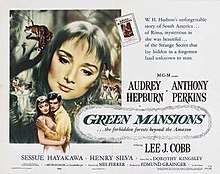
Pan and scan is a method of adjusting widescreen film images so that they can be shown in fullscreen proportions of a standard-definition 4:3 aspect ratio television screen, often cropping off the sides of the original widescreen image to focus on the composition's most important aspects.

35 mm film is a film gauge used in filmmaking, and the film standard. In motion pictures that record on film, 35 mm is the most commonly used gauge. The name of the gauge is not a direct measurement, and refers to the nominal width of the 35 mm format photographic film, which consists of strips 1.377 ± 0.001 inches (34.976 ± 0.025 mm) wide. The standard image exposure length on 35 mm for movies is four perforations per frame along both edges, which results in 16 frames per foot of film.
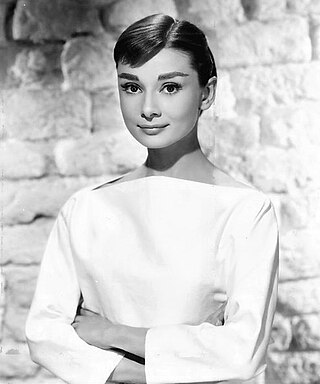
Audrey Kathleen Hepburn was a British actress. Recognised as a film and fashion icon, she was ranked by the American Film Institute as the third-greatest female screen legend from the Classical Hollywood cinema and was inducted into the International Best Dressed Hall of Fame List.
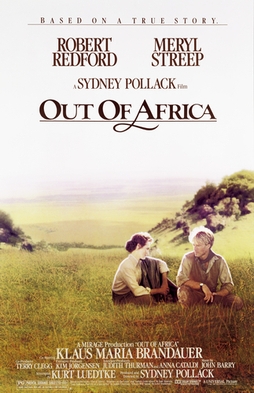
Out of Africa is a 1985 American epic romantic drama film directed and produced by Sydney Pollack, and starring Meryl Streep and Robert Redford. The film is based loosely on the 1937 autobiographical book Out of Africa written by Isak Dinesen, with additional material from Dinesen's 1960 book Shadows on the Grass and other sources.
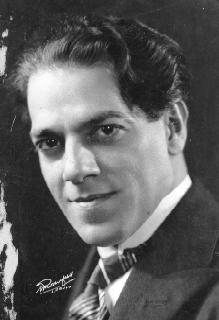
Heitor Villa-Lobos was a Brazilian composer, conductor, cellist, and classical guitarist described as "the single most significant creative figure in 20th-century Brazilian art music". Villa-Lobos has become the best-known South American composer of all time. A prolific composer, he wrote numerous orchestral, chamber, instrumental and vocal works, totaling over 2,000 works by his death in 1959. His music was influenced by both Brazilian folk music and stylistic elements from the European classical tradition, as exemplified by his Bachianas Brasileiras and his Chôros. His Etudes for classical guitar (1929) were dedicated to Andrés Segovia, while his 5 Preludes (1940) were dedicated to his spouse Arminda Neves d'Almeida, a.k.a. "Mindinha". Both are important works in the classical guitar repertory.

Lili is a 1953 American film released by MGM. It stars Leslie Caron as a touchingly naïve French girl whose emotional relationship with a carnival puppeteer is conducted through the medium of four puppets. The film won the Academy Award for Best Original Score, and was also entered in the 1953 Cannes Film Festival. It was later adapted for the stage under the title Carnival! (1961).

CinemaScope is an anamorphic lens series used, from 1953 to 1967, and less often later, for shooting widescreen films that, crucially, could be screened in theatres using existing equipment, albeit with a lens adapter.

Cinerama is a widescreen process that originally projected images simultaneously from three synchronized 35mm projectors onto a huge, deeply curved screen, subtending 146-degrees of arc. The trademarked process was marketed by the Cinerama corporation. It was the first of several novel processes introduced during the 1950s when the movie industry was reacting to competition from television. Cinerama was presented to the public as a theatrical event, with reserved seating and printed programs, and audience members often dressed in their best attire for the evening.
Bronisław Kaper was a Polish film composer who scored films and musical theater in Germany, France, and the USA. The American immigration authorities misspelled his name as Bronislau Kaper. He was also variously credited as Bronislaw Kaper, Bronislaw Kapper, Benjamin Kapper, and Edward Kane.
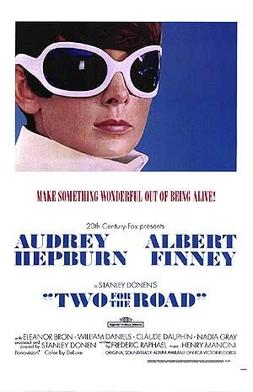
Two for the Road is a 1967 British romantic comedy-drama directed and produced by Stanley Donen, starring Audrey Hepburn and Albert Finney. The film tells the story of a married couple who reflect on their twelve-year relationship while on a road trip from England to the French Riviera. As they survey their foundering marriage in the present, the evolution of their relationship reveals itself through vignettes from four previous trips they took along the same route. The film was made from an original screenplay by Frederic Raphael. Supporting cast members include Eleanor Bron, William Daniels, Claude Dauphin, and Nadia Gray. Two for the Road was Hepburn's penultimate film before her semi-retirement in early 1967.

Panavision is an American motion picture equipment company founded in 1954 specializing in cameras and lenses, based in Woodland Hills, California. Formed by Robert Gottschalk as a small partnership to create anamorphic projection lenses during the widescreen boom in the 1950s, Panavision expanded its product lines to meet the demands of modern filmmakers. The company introduced its first products in 1954. Originally a provider of CinemaScope accessories, the company's line of anamorphic widescreen lenses soon became the industry leader. In 1972, Panavision helped revolutionize filmmaking with the lightweight Panaflex 35 mm movie camera. The company has introduced other cameras such as the Millennium XL (1999) and the digital video Genesis (2004).
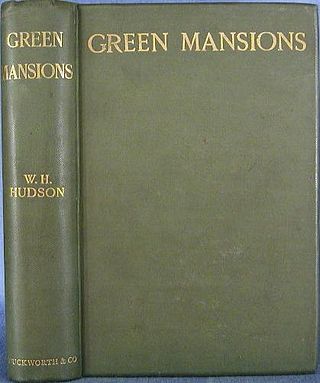
Green Mansions: A Romance of the Tropical Forest (1904) is an exotic romance by William Henry Hudson about a traveller to the Guyana jungle of southeastern Venezuela and his encounter with a forest-dwelling girl named Rima.
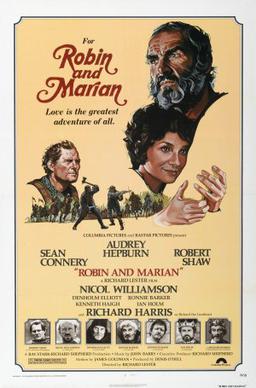
Robin and Marian is a 1976 British-American romantic adventure film from Columbia Pictures, shot in Panavision and Technicolor, that was directed by Richard Lester and written by James Goldman after the legend of Robin Hood. The film stars Sean Connery as Robin Hood, Audrey Hepburn as Lady Marian, Nicol Williamson as Little John, Robert Shaw as the Sheriff of Nottingham, Richard Harris as Richard the Lionheart, and Denholm Elliott as Will Scarlet. It also features comedian Ronnie Barker in a rare film role as Friar Tuck. Robin and Marian was filmed in Zamora, as well as Artajona, Urbasa, Quinto Real and Orgi, all small medieval villages in Navarre, Spain. It marked Hepburn's return to the screen after an eight-year absence.

Rima, also known as Rima the Jungle Girl, is the fictional heroine of W. H. Hudson's 1904 novel Green Mansions: A Romance of the Tropical Forest. In it, Rima, a primitive girl of the shrinking rain forest of South America, meets Abel, a political fugitive. A film adaptation of Green Mansions was made in 1959 starring Audrey Hepburn.
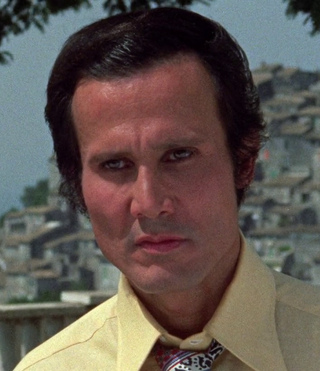
Henry Silva was an American actor. A prolific character actor, Silva was a regular staple of international genre cinema, usually playing criminals or gangsters. His notable film appearances include ones in Ocean's 11 (1960), The Manchurian Candidate (1962), Johnny Cool (1963), Sharky's Machine (1981), and Ghost Dog: The Way of the Samurai (1999).
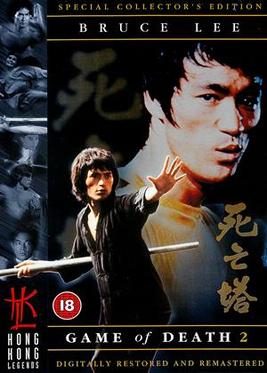
Game of Death II, also known as Tower of Death or The New Game of Death, is a 1981 Hong Kong martial arts film directed by Ng See-yuen and starring Bruce Lee, Tong Lung, Huong Cheng Li and Roy Horan. This film was marketed as a sequel to Bruce Lee's last and only partially completed film Game of Death. Bruce Lee died some years before the production of Game of Death II and most of his scenes are taken from Lee's older films, mostly Enter the Dragon. Aside from the international English dub giving the "Bruce Lee" character the name Billy Lo, this movie appears to have no connection with Robert Clouse's 1978 version of Game of Death.

War and Peace is a 1956 epic historical drama film based on Leo Tolstoy's 1869 novel of the same name. It is directed and co-written by King Vidor and produced by Dino De Laurentiis and Carlo Ponti for Paramount Pictures. The film stars Audrey Hepburn as Natasha, Henry Fonda as Pierre, and Mel Ferrer as Andrei, along with Oskar Homolka, Vittorio Gassman, Herbert Lom, Jeremy Brett, John Mills and Anita Ekberg in one of her first breakthrough roles. The musical score was composed by Nino Rota and conducted by Franco Ferrara.

Ride, Vaquero! is a 1953 American Western film photographed in Ansco Color made by Metro-Goldwyn-Mayer (MGM). It was directed by John Farrow and produced by Stephen Ames from a screenplay by Frank Fenton and John Farrow. The music score was by Bronislau Kaper and the cinematography by Robert Surtees.
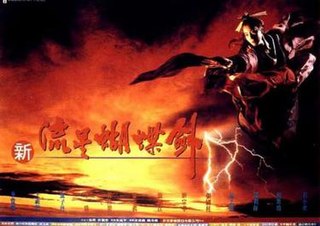
Butterfly and Sword is a 1993 Hong Kong wuxia film loosely based on the novel Liuxing Hudie Jian by Gu Long. Directed by Michael Mak, the film starred Tony Leung, Michelle Yeoh, Jimmy Lin, Joey Wong and Donnie Yen.

Raintree County is a 1957 American epic historical romance western film adapted from the 1948 novel of the same name by Ross Lockridge Jr. The film was directed by Edward Dmytryk and distributed by Metro-Goldwyn-Mayer. Set in the American South against the backdrop of the Antebellum South and the American Civil War, the film tells the story of a small-town Midwestern teacher and poet named John Shawnessy, who meets and marries a beautiful Southern belle named Susanna Drake; however, her emotional instability leads to the destruction of their marriage. The leading roles are played by Montgomery Clift, Elizabeth Taylor, Eva Marie Saint, Nigel Patrick and Lee Marvin.
